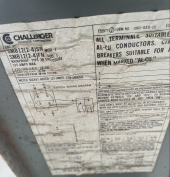I've been told by a few local electricians (including one who is a neighbor and knew the previous owner) that the 100 amp main panel can only have a 20 amp PV breaker, limiting me to a 4-ish kw PV system.
Honestly I've never heard of this limitation of 20a breakers in a 100a panel.
The limitation is a 20A PV breaker in a breaker panel with 100A rated busbar and 100A main breaker.
That's 20A + 100A of sources putting current into a 100A busbar.
(You could overstuff a 100A panel with 10x 50A breakers and that would never make busbar exceed the 100A available through main breaker.)
But if you put 20A PV breaker right next to 100A main breaker, there would be 120A available to flow through busbar, causing 1.44 times the temperature rise.
Yet if you put a 100A PV breaker at far end of the busbar, together with 100A main breaker there would be 200A available for loads and the busbar would never carry more than 100A, because current flowing in opposite directions would cancel.
The NEC authors knew a large PV breaker at far end would not be a problem, but were afraid it might later get relocated to near end. Allowing main breaker + PV breaker to total 120% of busbar rating was a compromise to allow PV to be added to existing panels where main breaker rating is equal to busbar rating.
OP's photo doesn't show a breaker panel. It shows what is probably a meter panel, with 100A disconnect, and a second position that has a 20A PV disconnect.
1) I think up to a 100A PV disconnect in place of the 20A would not cause an (technical) problem, so long as it was only a source of power not a consumer. Don't want 100A load from main disconnect and house while drawing additional load on 100A PV disconnect. SolArk is bidirectional, so problem is it could draw current (for protected loads or battery charging.) If strictly grid-tie PV inverter, I don't see a (technical) problem.
Some utilities allow a "line side tap" of up to 40A breaker. That's an additional 40A breaker connected between meter and what is usually a 100A main disconnect on customer's breaker panel. Replacing your 20A PV breaker with 40A would be like that. But for bidirectional SolArk might overheat utility drop wires.
2) We don't have details on breaker panel. With suitable busbar rating it could have up to 100A PV breaker on it. It would either receive up to 100A from grid, or backfeed up to 100A from grid (utility agreement will have a limit on backfeed due to their system planning and grid stability.)
This is where I said, "Just put in a 200A panel and you can have up to 100A PV breaker."
3) Not using that 20A PV breaker, could tap off that 100A breaker to feed two panels. One is the existing breaker panel, another would feed Sol-Ark. Instead of a panel, could just be fused for Sol-Ark. If you do this, 100A from main breaker + ??A from Sol-Ark are available to go to breaker panel and the wire feeding it. This could easily be excessive. I would put a suitable main breaker in (or fuse before) the breaker panel, likely 100A.



